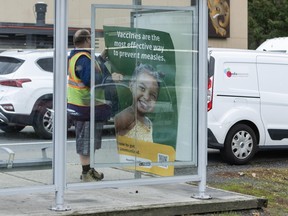Health
B.C. Childhood Vaccination Rates Decline Post-Pandemic

Childhood vaccination rates in British Columbia (B.C.) have not recovered from the decline observed during the COVID-19 pandemic, according to recent data from the B.C. Centre for Disease Control (BCCDC). While vaccination campaigns have resumed, significant gaps remain, particularly among younger children.
Data indicates a “small-to-medium decline” in routine childhood vaccinations since 2021, as highlighted by Dr. Jia Hu, interim medical director of immunization programs at the BCCDC. The rates have decreased almost 10 percent over three years, dropping from 72.5 percent in 2021 to 63.8 percent in 2024. This trend is particularly concerning among seven-year-olds, where more than one-third of second graders are not up-to-date on essential vaccinations for diseases such as mumps and measles.
The ongoing impact of the pandemic is only part of the story. Many British Columbians have recently received notifications urging them to schedule their seasonal flu and COVID-19 vaccinations, yet the decline in routine childhood immunizations suggests that barriers still exist. Dr. Hu noted that while the number of documented refusals—where parents explicitly state they do not wish to vaccinate their children—has remained stable, this could imply that the actual immunization rate is higher than reported.
As families have moved frequently, especially in the aftermath of increased migration, health records may not be up-to-date, contributing to the perceived decline. Despite these challenges, the data remains valuable for assessing overall vaccination trends and identifying areas where improvements are needed.
Examining immunization rates for two-year-olds reveals that the drop is not limited to those who missed appointments during the pandemic. Vaccination coverage for toddlers born after the pandemic remains below the rates observed between 2016 and 2020, when it ranged between 73 percent and 74.3 percent. In 2024, only 69.5 percent of two-year-olds in B.C. were up-to-date with their routine vaccinations.
Vaccine hesitancy has emerged as a notable factor in this decline. A recent poll conducted by Angus Reid found that one in six Canadian parents with children under 18 expressed strong opposition to vaccinating their kids, a sharp increase from 2019. Additionally, the proportion of parents unsure about vaccinating their young children doubled during this period, from 8 percent to 16 percent. Such shifts prompted Brian Conway, medical director of the Vancouver Infectious Diseases Centre, to describe the situation as “a disaster of epic proportions.”
Despite the challenges, there is a glimmer of hope. According to BCCDC data, children often catch up on vaccinations as they grow older. Public health initiatives, including school-based clinics offering scheduled vaccines in Grade 6 and Grade 9, have shown effectiveness in improving coverage. By Grade 9, vaccination rates for all antigens have risen from lows experienced in 2021, when the pandemic affected available resources for public health initiatives.
Moreover, there has been a significant uptick in the uptake of the measles-mumps-rubella vaccine, with reported increases of 30 to 40 percent compared to last year, likely spurred by a rise in measles cases—102 cases were reported across the province as of July. Nevertheless, measles immunization coverage for seven-year-olds in 2024 was recorded at 70 percent, lower than the rates for German measles and hepatitis B, which exceeded 80 percent.
Health officials are utilizing immunization coverage data to direct campaigns and resources to areas with the lowest vaccination rates. The Kootenay Boundary region in the Interior Health area recorded just 54 percent coverage for seven-year-olds in 2023, with the Okanagan region at 60 percent. In Fraser Health, Fraser North had the lowest rate at 63.4 percent, while Vancouver recorded 63 percent. In contrast, the highest rates were seen in Northern Health, where coverage reached 75.6 percent.
In an effort to further improve vaccination rates, the province is simplifying the human papillomavirus (HPV) vaccine schedule and expanding eligibility to individuals aged 19 to 26. In 2023, HPV vaccination rates for females in Grade 9 stood at 60 percent, while it was 57.7 percent for males.
As part of ongoing efforts to encourage immunization, the province has begun sending notifications for seasonal flu and COVID-19 vaccine appointments, which are available at no cost to residents. The first vaccinations were administered to British Columbians on Tuesday, marking another step in the province’s commitment to improving public health through vaccination.
-

 Science2 months ago
Science2 months agoToyoake City Proposes Daily Two-Hour Smartphone Use Limit
-

 Health2 months ago
Health2 months agoB.C. Review Reveals Urgent Need for Rare-Disease Drug Reforms
-

 Top Stories2 months ago
Top Stories2 months agoPedestrian Fatally Injured in Esquimalt Collision on August 14
-

 Technology2 months ago
Technology2 months agoDark Adventure Game “Bye Sweet Carole” Set for October Release
-

 World2 months ago
World2 months agoJimmy Lai’s Defense Challenges Charges Under National Security Law
-

 Technology2 months ago
Technology2 months agoKonami Revives Iconic Metal Gear Solid Delta Ahead of Release
-

 Technology2 months ago
Technology2 months agoSnapmaker U1 Color 3D Printer Redefines Speed and Sustainability
-

 Technology2 months ago
Technology2 months agoAION Folding Knife: Redefining EDC Design with Premium Materials
-

 Technology2 months ago
Technology2 months agoSolve Today’s Wordle Challenge: Hints and Answer for August 19
-

 Business2 months ago
Business2 months agoGordon Murray Automotive Unveils S1 LM and Le Mans GTR at Monterey
-

 Lifestyle2 months ago
Lifestyle2 months agoVictoria’s Pop-Up Shop Shines Light on B.C.’s Wolf Cull
-

 Technology2 months ago
Technology2 months agoApple Expands Self-Service Repair Program to Canada









